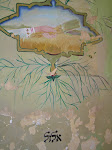So for those out there who are not so familiar with conservation, it might be useful to have a very brief introduction. According to the American Institute of Conservation for Historic and Artistic Works (AIC)-- the professional affiliation group to which many North American conservators belong--
“The primary goal of conservation professionals, individuals with extensive training and special expertise, is the preservation of cultural property. Cultural property consists of individual objects, structures, or collections. It has significance that may be artistic, historical, scientific, religious, or social, and it is an invaluable and irreplaceable legacy that must be preserved for future generations.”
You can read more information on AIC's website at
http://www.conservation-us.org/
The essential gist here is that we help to keep cultural property safe- whether a painting, building, book OR wall painting- for future generations. Sometimes this work involves lots of physical activity on the actual object, for instance, using different chemicals to reduce soiling on a painted surface-- and sometimes it involves trying to control the environment around the object, through climate controls like an HVAC system. Often times conservators consider themselves the advocate for these objects, because as we all know, paintings cannot speak for themselves.
Conservators are professionally trained, either through graduate schools or as apprentices in other conservation workshops. Today, most people entering the field do study at the graduate level, and typically receive a master's degree. Several graduate schools offer this type of study, including the Conservation Center at the Institute of Fine Arts at New York University; Buffalo State College; University of Delaware, Winterthur; UCLA in partnership with the Getty; and The University of Texas at Austin (for book conservation). Even more universities offer degrees in historic preservation, which is the conservation of the built environment.
Please let us know if you-- the reader-- have any questions about this. As we start working on the Stanton Street painting, I think some of this information will really come to life.
Subscribe to:
Post Comments (Atom)
01.jpg)
No comments:
Post a Comment